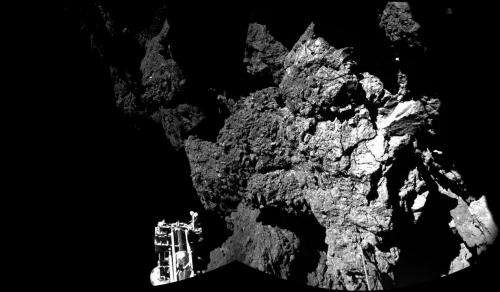Space agency releases first picture from comet

The European Space Agency on Thursday published the first image taken from the surface of a comet, and said that its Philae lander is still "stable" despite a failure to latch on properly to the rocky terrain.
The lander scored a historic first Wednesday, touching down on comet 67P/Churyumov-Gerasimenko after a decade-long, 6.4 billion-kilometer (4 billion-mile) journey through space aboard its mother ship Rosetta.
Scientists' jubilation was slightly dampened because the harpoons which were meant to anchor the lander to the surface failed to deploy, causing it to bounce twice before it came to rest on the comet's 4 kilometer-wide body, or nucleus.
"Philae is stable, sitting on the nucleus and is producing data," Gerhard Schwehm, a scientist on the Rosetta mission, told The Associated Press. "The lander is very healthy."
The photo sent back to Earth shows a rocky surface, with one of the lander's three feet in the corner of the frame.
Scientists are still analyzing what effect the two bounces had on the spacecraft and plan to release further details at a news briefing at 2 p.m. (1300 GMT; 8 a.m. EST). Communication with the lander is slow, with signals taking more than 28 minutes to travel some 500 million kilometers (300 million miles) between Earth and the Rosetta orbiter.
Schwehm said it may still be possible to fire the harpoons but that this would be done only if it doesn't imperil the lander.
Another key question is whether Philae's drill can be used to extract samples from beneath the surface without pushing the lander into space. Gravity on the comet is 1/100,000th that of Earth, meaning the washing machine-sized lander weighs just 1 gram (0.04 ounces) there.
Philae and Rosetta will use 21 instruments to analyze the comet over the coming months. Scientists hope the €1.3 billion ($1.6 billion) project will help them better understand comets and other celestial objects, as well as possibly answer questions about the origins of life on Earth.
© 2014 The Associated Press. All rights reserved.





















